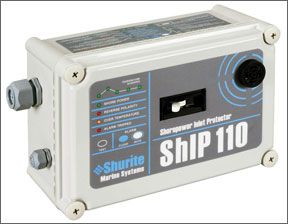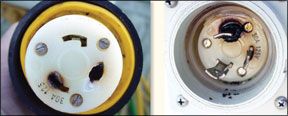With the increased demand to have all the electrically powered comforts of home onboard, it should come as no surprise to boaters that the majority of AC-related electrical fires involve overheated shore-power plugs and receptacles. Prime Technology, aims to change all that with the introduction of its Shore Power Inlet Protector (ShIP for short), a monitoring and alarm device that automatically disconnects AC shore power when excessive heat is detected at the power inlet connector. We reviewed the ShIP 110 designed for use with a 110-volt, 30-amp system. The company also offers a similar unit (the ShIP 220) for use with 220-volt, 50-amp service.

Charred plugs and receptacles are the result of resistance build-up (due to loose or corroded connections), which generates heat and the potential for fire, a problem especially prevalent among vessels that continually run high energy loads such as water heaters and air-conditioning units. In addition to monitoring the temperature of your vessels shore-power inlet plug and its wiring, the ShIP system automatically disconnects AC shore power when an unsafe temperature is detected, providing visual and audible alarms. (The audible alarm shuts down after five minutes to avoid prolonged disturbance to surrounding boats.)
Other features include a reverse polarity indicator light, built-in self-tester, and a contact closure interface that can be used to trigger an external device, such as those programmed to initiate a phone call or send an e-mail in the event of a triggered alarm.

The weather-resistant enclosure is constructed of a non-corrosive composite material, measures 7.5x11x5.5 inches, and weighs approximately 5 pounds. Its designed to be bulkhead-mounted in the vertical position and inserted in the AC wiring at some point between the shore-power inlet connector and main breaker panel. Other installation considerations would be its large size and the fact that the ShIP units are not ignition protected, meaning they can’t be installed near flammable liquids (such as the engine compartment of a gasoline-powered boat). The ShIP 110 is not UL listed, though it claims compliance with all applicable American Boat and Yacht Council standards.
Bottom line
. Our testers liked the concept of the ShIP 110 unit and found the construction quality to be excellent. However, the $1,150 price is steep. Were keeping our eyes out for a smaller, less expensive solution geared toward the average sailor.


































